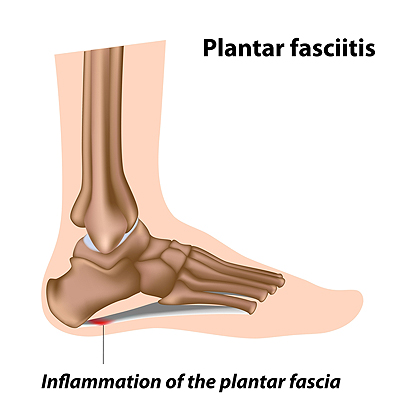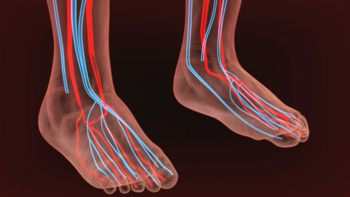Connect With Us
Blog
Items filtered by date: August 2019
Is Plantar Fasciitis Painful?
 The most noticeable symptoms of the medical condition that is known as plantar fasciitis are heel pain and severe discomfort. The plantar fascia is located on the bottom of the foot, and it connects the heel to the toes. If this becomes injured, it may become inflamed, and plantar fasciitis may develop. This condition can be caused by high arches, an injury that has happened to the foot, or participating in certain sporting activities. Relief can be felt when orthotics are worn, and this may be beneficial in reducing existing strain to the plantar fascia. Some patients find it helpful to perform frequent stretching techniques, and this may also aid in strengthening the affected areas of the foot. If you have heel pain, please consult with a podiatrist who can begin the correct treatment options for you.
The most noticeable symptoms of the medical condition that is known as plantar fasciitis are heel pain and severe discomfort. The plantar fascia is located on the bottom of the foot, and it connects the heel to the toes. If this becomes injured, it may become inflamed, and plantar fasciitis may develop. This condition can be caused by high arches, an injury that has happened to the foot, or participating in certain sporting activities. Relief can be felt when orthotics are worn, and this may be beneficial in reducing existing strain to the plantar fascia. Some patients find it helpful to perform frequent stretching techniques, and this may also aid in strengthening the affected areas of the foot. If you have heel pain, please consult with a podiatrist who can begin the correct treatment options for you.
Plantar fasciitis is a common foot condition that is often caused by a strain injury. If you are experiencing heel pain or symptoms of plantar fasciitis, contact one of our podiatrists from Sutera and Jones Surgical Podiatry. Our doctors can provide the care you need to keep you pain-free and on your feet.
What Is Plantar Fasciitis?
Plantar fasciitis is one of the most common causes of heel pain. The plantar fascia is a ligament that connects your heel to the front of your foot. When this ligament becomes inflamed, plantar fasciitis is the result. If you have plantar fasciitis you will have a stabbing pain that usually occurs with your first steps in the morning. As the day progresses and you walk around more, this pain will start to disappear, but it will return after long periods of standing or sitting.
What Causes Plantar Fasciitis?
- Excessive running
- Having high arches in your feet
- Other foot issues such as flat feet
- Pregnancy (due to the sudden weight gain)
- Being on your feet very often
There are some risk factors that may make you more likely to develop plantar fasciitis compared to others. The condition most commonly affects adults between the ages of 40 and 60. It also tends to affect people who are obese because the extra pounds result in extra stress being placed on the plantar fascia.
Prevention
- Take good care of your feet – Wear shoes that have good arch support and heel cushioning.
- Maintain a healthy weight
- If you are a runner, alternate running with other sports that won’t cause heel pain
There are a variety of treatment options available for plantar fasciitis along with the pain that accompanies it. Additionally, physical therapy is a very important component in the treatment process. It is important that you meet with your podiatrist to determine which treatment option is best for you.
If you have any questions, please feel free to contact one of our offices located in Media and Glen Mills, PA . We offer the newest diagnostic and treatment technologies for all your foot care needs.
Read more about Plantar Fasciitis
Is Plantar Fasciitis Painful?
 The most noticeable symptoms of the medical condition that is known as plantar fasciitis are heel pain and severe discomfort. The plantar fascia is located on the bottom of the foot, and it connects the heel to the toes. If this becomes injured, it may become inflamed, and plantar fasciitis may develop. This condition can be caused by high arches, an injury that has happened to the foot, or participating in certain sporting activities. Relief can be felt when orthotics are worn, and this may be beneficial in reducing existing strain to the plantar fascia. Some patients find it helpful to perform frequent stretching techniques, and this may also aid in strengthening the affected areas of the foot. If you have heel pain, please consult with a podiatrist who can begin the correct treatment options for you.
The most noticeable symptoms of the medical condition that is known as plantar fasciitis are heel pain and severe discomfort. The plantar fascia is located on the bottom of the foot, and it connects the heel to the toes. If this becomes injured, it may become inflamed, and plantar fasciitis may develop. This condition can be caused by high arches, an injury that has happened to the foot, or participating in certain sporting activities. Relief can be felt when orthotics are worn, and this may be beneficial in reducing existing strain to the plantar fascia. Some patients find it helpful to perform frequent stretching techniques, and this may also aid in strengthening the affected areas of the foot. If you have heel pain, please consult with a podiatrist who can begin the correct treatment options for you.
Plantar fasciitis is a common foot condition that is often caused by a strain injury. If you are experiencing heel pain or symptoms of plantar fasciitis, contact one of our podiatrists from Sutera and Jones Surgical Podiatry. Our doctors can provide the care you need to keep you pain-free and on your feet.
What Is Plantar Fasciitis?
Plantar fasciitis is one of the most common causes of heel pain. The plantar fascia is a ligament that connects your heel to the front of your foot. When this ligament becomes inflamed, plantar fasciitis is the result. If you have plantar fasciitis you will have a stabbing pain that usually occurs with your first steps in the morning. As the day progresses and you walk around more, this pain will start to disappear, but it will return after long periods of standing or sitting.
What Causes Plantar Fasciitis?
- Excessive running
- Having high arches in your feet
- Other foot issues such as flat feet
- Pregnancy (due to the sudden weight gain)
- Being on your feet very often
There are some risk factors that may make you more likely to develop plantar fasciitis compared to others. The condition most commonly affects adults between the ages of 40 and 60. It also tends to affect people who are obese because the extra pounds result in extra stress being placed on the plantar fascia.
Prevention
- Take good care of your feet – Wear shoes that have good arch support and heel cushioning.
- Maintain a healthy weight
- If you are a runner, alternate running with other sports that won’t cause heel pain
There are a variety of treatment options available for plantar fasciitis along with the pain that accompanies it. Additionally, physical therapy is a very important component in the treatment process. It is important that you meet with your podiatrist to determine which treatment option is best for you.
If you have any questions, please feel free to contact one of our offices located in Media, Glen Mills, Riddle Memorial Hospital, and Concordville, PA . We offer the newest diagnostic and treatment technologies for all your foot care needs.
Swollen Feet and Ankles Can Be Common During Pregnancy
 The human body undergoes extensive changes during pregnancy, and many of these changes can affect the feet. A common condition that many pregnant women notice is swelling in the ankles and feet, and this is typically a result of increased blood pressure that can occur during pregnancy. The toenails may change shape, and this can cause ingrown toenails to develop. Additionally, flat feet is a common ailment during the latter stages of pregnancy, and this is often recognized by experiencing foot pain. Mild relief can be felt when the feet are elevated, and this may help to reduce existing swelling. If you are having chronic foot issues while pregnant, it is suggested that you speak with a podiatrist who can treat any foot condition
The human body undergoes extensive changes during pregnancy, and many of these changes can affect the feet. A common condition that many pregnant women notice is swelling in the ankles and feet, and this is typically a result of increased blood pressure that can occur during pregnancy. The toenails may change shape, and this can cause ingrown toenails to develop. Additionally, flat feet is a common ailment during the latter stages of pregnancy, and this is often recognized by experiencing foot pain. Mild relief can be felt when the feet are elevated, and this may help to reduce existing swelling. If you are having chronic foot issues while pregnant, it is suggested that you speak with a podiatrist who can treat any foot condition
Pregnant women with swollen feet can be treated with a variety of different methods that are readily available. For more information about other cures for swollen feet during pregnancy, consult with one of our podiatrists from Sutera and Jones Surgical Podiatry. Our doctors will attend to all of your foot and ankle needs.
What Foot Problems Can Arise During Pregnancy?
One problem that can occur is overpronation, which occurs when the arch of the foot flattens and tends to roll inward. This can cause pain and discomfort in your heels while you’re walking or even just standing up, trying to support your baby.
Another problem is edema, or swelling in the extremities. This often affects the feet during pregnancy but tends to occur in the later stages.
How Can I Keep My Feet Healthy During Pregnancy?
- Wearing orthotics can provide extra support for the feet and help distribute weight evenly
- Minimize the amount of time spent walking barefoot
- Wear shoes with good arch support
- Wear shoes that allow for good circulation to the feet
- Elevate feet if you experience swelling
- Massage your feet
- Get regular, light exercise, such as walking, to promote blood circulation to the feet
If you have any questions please feel free to contact one of our offices located in Media and Glen Mills, PA . We offer the newest diagnostic and treatment technologies for all your foot and ankle needs.
Read more about Foot Care for Pregnant WomenSwollen Feet and Ankles Can Be Common During Pregnancy
 The human body undergoes extensive changes during pregnancy, and many of these changes can affect the feet. A common condition that many pregnant women notice is swelling in the ankles and feet, and this is typically a result of increased blood pressure that can occur during pregnancy. The toenails may change shape, and this can cause ingrown toenails to develop. Additionally, flat feet is a common ailment during the latter stages of pregnancy, and this is often recognized by experiencing foot pain. Mild relief can be felt when the feet are elevated, and this may help to reduce existing swelling. If you are having chronic foot issues while pregnant, it is suggested that you speak with a podiatrist who can treat any foot condition
The human body undergoes extensive changes during pregnancy, and many of these changes can affect the feet. A common condition that many pregnant women notice is swelling in the ankles and feet, and this is typically a result of increased blood pressure that can occur during pregnancy. The toenails may change shape, and this can cause ingrown toenails to develop. Additionally, flat feet is a common ailment during the latter stages of pregnancy, and this is often recognized by experiencing foot pain. Mild relief can be felt when the feet are elevated, and this may help to reduce existing swelling. If you are having chronic foot issues while pregnant, it is suggested that you speak with a podiatrist who can treat any foot condition
Pregnant women with swollen feet can be treated with a variety of different methods that are readily available. For more information about other cures for swollen feet during pregnancy, consult with one of our podiatrists from Sutera and Jones Surgical Podiatry. Our doctors will attend to all of your foot and ankle needs.
What Foot Problems Can Arise During Pregnancy?
One problem that can occur is overpronation, which occurs when the arch of the foot flattens and tends to roll inward. This can cause pain and discomfort in your heels while you’re walking or even just standing up, trying to support your baby.
Another problem is edema, or swelling in the extremities. This often affects the feet during pregnancy but tends to occur in the later stages.
How Can I Keep My Feet Healthy During Pregnancy?
- Wearing orthotics can provide extra support for the feet and help distribute weight evenly
- Minimize the amount of time spent walking barefoot
- Wear shoes with good arch support
- Wear shoes that allow for good circulation to the feet
- Elevate feet if you experience swelling
- Massage your feet
- Get regular, light exercise, such as walking, to promote blood circulation to the feet
If you have any questions please feel free to contact one of our offices located in Media, Glen Mills, Riddle Memorial Hospital, and Concordville, PA . We offer the newest diagnostic and treatment technologies for all your foot and ankle needs.
Common Symptoms Of Poor Circulation
 People who experience poor circulation in the feet often have similar symptoms. These can include a tingling and numbing sensation, extreme fatigue, and the feet may feel cold. Some patients also notice swelling in their feet, and this can indicate other health issues. There are a variety of causes that may lead to poor circulation. The most common reason is a condition known as atherosclerosis. A buildup of plaque in the blood vessels takes place, especially in the arteries, eventually restricting natural blood flow. Additionally, diabetic patients may suffer from this ailment, and this may be a result of damaged blood vessels caused by elevated sugar levels. Mild treatment options can include losing excess weight, quitting smoking, and incorporating a healthy diet as part of your daily meal plan. If you notice you are having symptoms of poor circulation in your feet, it is suggested that you schedule a consultation with a podiatrist.
People who experience poor circulation in the feet often have similar symptoms. These can include a tingling and numbing sensation, extreme fatigue, and the feet may feel cold. Some patients also notice swelling in their feet, and this can indicate other health issues. There are a variety of causes that may lead to poor circulation. The most common reason is a condition known as atherosclerosis. A buildup of plaque in the blood vessels takes place, especially in the arteries, eventually restricting natural blood flow. Additionally, diabetic patients may suffer from this ailment, and this may be a result of damaged blood vessels caused by elevated sugar levels. Mild treatment options can include losing excess weight, quitting smoking, and incorporating a healthy diet as part of your daily meal plan. If you notice you are having symptoms of poor circulation in your feet, it is suggested that you schedule a consultation with a podiatrist.
Poor circulation is a serious condition and needs immediate medical attention. If you have any concerns with poor circulation in your feet contact one of our podiatrists of Sutera and Jones Surgical Podiatry. Our doctors will treat your foot and ankle needs.
Poor Circulation in the Feet
Poor blood circulation in the feet and legs is can be caused by peripheral artery disease (PAD), which is the result of a buildup of plaque in the arteries.
Plaque buildup or atherosclerosis results from excess calcium and cholesterol in the bloodstream. This can restrict the amount of blood which can flow through the arteries. Poor blood circulation in the feet and legs are sometimes caused by inflammation in the blood vessels, known as vasculitis.
Causes
Lack of oxygen and oxygen from poor blood circulation restricts muscle growth and development. It can also cause:
- Muscle pain, stiffness, or weakness
- Numbness or cramping in the legs
- Skin discoloration
- Slower nail & hair growth
- Erectile dysfunction
Those who have diabetes or smoke are at greatest risk for poor circulation, as are those who are over 50. If you have poor circulation in the feet and legs it may be caused by PAD and is important to make changes to your lifestyle in order to reduce risk of getting a heart attack or stroke. Exercise and maintaining a healthy lifestyle will dramatically improve conditions.
As always, see a podiatrist as he or she will assist in finding a regimen that suits you. A podiatrist can also prescribe you any needed medication.
If you have any questions please feel free to contact one of our offices located in Media and Glen Mills, PA . We offer the newest diagnostic and treatment technologies for all your foot and ankle needs.
Read more about Causes, Symptoms, and Treatment of Poor Blood Circulation in the FeetCommon Symptoms Of Poor Circulation
 People who experience poor circulation in the feet often have similar symptoms. These can include a tingling and numbing sensation, extreme fatigue, and the feet may feel cold. Some patients also notice swelling in their feet, and this can indicate other health issues. There are a variety of causes that may lead to poor circulation. The most common reason is a condition known as atherosclerosis. A buildup of plaque in the blood vessels takes place, especially in the arteries, eventually restricting natural blood flow. Additionally, diabetic patients may suffer from this ailment, and this may be a result of damaged blood vessels caused by elevated sugar levels. Mild treatment options can include losing excess weight, quitting smoking, and incorporating a healthy diet as part of your daily meal plan. If you notice you are having symptoms of poor circulation in your feet, it is suggested that you schedule a consultation with a podiatrist.
People who experience poor circulation in the feet often have similar symptoms. These can include a tingling and numbing sensation, extreme fatigue, and the feet may feel cold. Some patients also notice swelling in their feet, and this can indicate other health issues. There are a variety of causes that may lead to poor circulation. The most common reason is a condition known as atherosclerosis. A buildup of plaque in the blood vessels takes place, especially in the arteries, eventually restricting natural blood flow. Additionally, diabetic patients may suffer from this ailment, and this may be a result of damaged blood vessels caused by elevated sugar levels. Mild treatment options can include losing excess weight, quitting smoking, and incorporating a healthy diet as part of your daily meal plan. If you notice you are having symptoms of poor circulation in your feet, it is suggested that you schedule a consultation with a podiatrist.
Poor circulation is a serious condition and needs immediate medical attention. If you have any concerns with poor circulation in your feet contact one of our podiatrists of Sutera and Jones Surgical Podiatry. Our doctors will treat your foot and ankle needs.
Poor Circulation in the Feet
Poor blood circulation in the feet and legs is can be caused by peripheral artery disease (PAD), which is the result of a buildup of plaque in the arteries.
Plaque buildup or atherosclerosis results from excess calcium and cholesterol in the bloodstream. This can restrict the amount of blood which can flow through the arteries. Poor blood circulation in the feet and legs are sometimes caused by inflammation in the blood vessels, known as vasculitis.
Causes
Lack of oxygen and oxygen from poor blood circulation restricts muscle growth and development. It can also cause:
- Muscle pain, stiffness, or weakness
- Numbness or cramping in the legs
- Skin discoloration
- Slower nail & hair growth
- Erectile dysfunction
Those who have diabetes or smoke are at greatest risk for poor circulation, as are those who are over 50. If you have poor circulation in the feet and legs it may be caused by PAD and is important to make changes to your lifestyle in order to reduce risk of getting a heart attack or stroke. Exercise and maintaining a healthy lifestyle will dramatically improve conditions.
As always, see a podiatrist as he or she will assist in finding a regimen that suits you. A podiatrist can also prescribe you any needed medication.
If you have any questions please feel free to contact one of our offices located in Media, Glen Mills, Riddle Memorial Hospital, and Concordville, PA . We offer the newest diagnostic and treatment technologies for all your foot and ankle needs.
Blog Archives
- July 2024
- June 2024
- May 2024
- April 2024
- March 2024
- February 2024
- January 2024
- December 2023
- November 2023
- October 2023
- September 2023
- August 2023
- July 2023
- June 2023
- May 2023
- April 2023
- March 2023
- February 2023
- January 2023
- December 2022
- November 2022
- October 2022
- September 2022
- August 2022
- July 2022
- June 2022
- May 2022
- April 2022
- March 2022
- February 2022
- January 2022
- December 2021
- November 2021
- October 2021
- September 2021
- August 2021
- July 2021
- June 2021
- May 2021
- April 2021
- March 2021
- February 2021
- January 2021
- December 2020
- November 2020
- October 2020
- September 2020
- August 2020
- July 2020
- June 2020
- May 2020
- April 2020
- March 2020
- February 2020
- January 2020
- December 2019
- November 2019
- October 2019
- September 2019
- August 2019
- July 2019
- June 2019
- May 2019
- April 2019
- March 2019
- February 2019
- January 2019
- December 2018
- November 2018
- October 2018
- September 2018
- August 2018
- July 2018
- June 2018
- May 2018
- April 2018
- March 2018
- February 2018
- January 2018
- December 2017
- November 2017
- October 2017
- September 2017
- August 2017
- July 2017
- June 2017
- May 2017
- April 2017
- March 2017
- February 2017
- January 2017
- December 2016
- November 2016
- October 2016
- September 2016
- August 2016
- July 2016
- June 2016
- May 2016
- April 2016
- March 2016
- February 2016
- January 2016
- December 2015
- November 2015
- October 2015
- September 2015
- August 2015
- July 2015
- June 2015
- May 2015
- April 2015
- March 2015
- February 2015
- January 2015
- December 2014
- November 2014
- October 2014
- September 2014

